Everything you need to know about WLTP
If you are in the market to buy a car at the moment, you may have noticed that the WLTP standard is featured somewhere in the small print. The WLTP is essentially a testing procedure that is implemented to determine the CO2 emissions and real-world fuel economy of a vehicle.Below, we will explain everything you need to know about WLTP so that you can get a better understanding of what it is and the benefits that are associated with them.
What is WLTP and how does it work?
WLTP stands for the Worldwide Harmonised Light Vehicle Test Procedure. It is a test that was created with the aim of being utilised as a global test cycle across various world regions, so CO2 emissions, fuel consumption values, and pollutants would be comparable around the world. In basic terms, it will determine the fuel efficiency rating for all hybrid, electric, diesel, and petrol vehicles. These are the figures that you will see online and in brochures when buying a vehicle.
Nevertheless, while there is a common worldwide ‘core’ as part of the WLTP, the EU and other regions need to apply the test in various ways depending on the road traffic laws and requirements.
How the WLTP test work
The test procedure with the WLTP is very similar to the NEDC in terms of the process, as it is carried out on a rolling road in lab conditions. Nevertheless, the WLTP is longer. It lasts for 30 minutes, whereas the NEDC was 20 minutes in length. Furthermore, the temperature is set to 23 degrees Celsius.
There are five driving cycles as part of the WLTP. This includes those with higher maximum and average speeds to reflect modern-day driving, like traffic, different road terrains, and different speed limits, as well as sharper deceleration and acceleration.
The part of the procedure that is known as the Real Driving Emissions (RDE) will last between 1.5 and 2 hours and is around 50 miles. The RDE will have an equal split of motorway, rural, and urban routes. In basic terms, it is a validation exercise for the WLTP results.

Old and New WLTP test
It is important to distinguish between the old test and the new WLTP test. The old lab test was known as the New European Driving Cycle, abbreviated to NEDC. This was created in the 1980s. However, as driving conditions have changed and technology has progressed, the test ended up being outdated. This is why a new test was created; the Worldwide Harmonised Light Vehicle Test Procedure (WLTP).
The WLTP is modernised and it better represents everyday driving profiles. This is because real-driving data that has been gathered from around the world has been used to develop WLTP. On the flip side, the old NEDC test determined test values based on a theoretical driving profile.
When did the new WLTP come into place?
The WLTP was first introduced in 2017 to replace the previous NEDC, which has been in play since the 1980s. However, as mentioned above, it had come under a lot of criticism for being unreliable. WLTP became mandatory from the 1st of September in 2018 for measuring fuel economy and CO2 emissions on all new vehicles in the EU.
In the United Kingdom, it was on the 1st of January in 2019 that the WLTP fuel economy values were brought into play. Nevertheless, CO2 figures were not disclosed until the 1st of April of 2020 to tally with the taxation changes.
An overview of the main changes that have been introduced
To help you further understand why WLTP is the natural progression from the outdated NEDC, let’s take a look at the main changes in full:
- Measurement is taken at 23 degrees Celsius, rather than in a range.
- There are various gear shift points, which depend on the car in question.
- The impact of optional equipment that can impact fuel usage and CO2 output will be accessed.
- The maximum speed throughout the process has increased to 81 mph rather than 74 mph.
- The average speed of the test has increased to 28.9 mph from 21 mph.
- There are more dynamic phases, as well as there being a near-even split between rural and urban driving.
- The distance of the test has doubled to almost 14.5 miles, rather than six miles.
- The cycle time has also risen by 50 per cent to 30 minutes, rather than 20 minutes.
- There is more variety in the test cycle so that real-world driving is better simulated.

What is the purpose of a WLTP test?
Many years ago, when it came to vehicle manufacturing, pollutants were an afterthought. Performance always came first. Nevertheless, as there were changes to legislation, mindsets started to change. We have seen that some higher polluting vehicles have been banned from city centres and are subject to higher road tax bills. Because of this, vehicle emissions are now a critical consideration for both manufacturers and buyers. It was imperative that there was some type of realistic test that would provide an accurate and reliable picture regarding the emissions vehicles emit. This is why the WLTP test was created.
What are the benefits of a WLTP test?
There are a lot of different benefits that you can expect with WLTP, and so it is not difficult to see why this was implemented over NEDC.
Much more accurate results
The WLTP introduces much more realistic testing conditions. Because of this, there is a much more accurate basis for calculating the fuel emissions and consumption of a vehicle. This will make certain that the lab measurements offer a better reflection of the on-road performance of the vehicle.
How the WLTP implements much more realistic testing conditions is by including all of the following:
- Enables worst-case and best-case values based on customer information, reflecting the options that are available for smaller car models.
- Stricter car measurement and set-up conditions.
- Optional equipment is considered, with fuel consumption and CO2 values provided for individual cars as constructed.
- Shorter stops
- More representative and dynamic decelerations and accelerations.
- Higher maximum and average drive power.
- Higher maximum and average speeds.
- Most realistic ambient temperatures, which are closer to the average in Europe.
- Longer testing distances.
- An improved range of driving situations, including the motorway, main roads, suburban, and urban driving.
- More realistic driving behaviour.
You will get a better understanding of car performance
Another benefit of WLTP is that you are going to get a much better understanding of how your car performs in different conditions. However, a lot of people have vehicles, but they do not all do the same sort of journeys. Some people use their car as a run around to get to and from work every day. Other people take long-distance journeys. Therefore, it is important to have an understanding of how your vehicle is going to perform in conditions that you are most likely to experience, and this is what WLTP provides.
Plug-in hybrids and electric vehicles can also be tested
If you have an electric or hybrid vehicle, you may assume that WLTP will not benefit you. However, this is not the case. Due to the complex nature of plug-in hybrid vehicles, otherwise known as PHEVs, there has been a new way of testing these vehicles that the WLTP has introduced.
Under these new conditions, plug-in hybrids will need to complete the test on a number of occasions, for instance, they will begin with a battery that is completely charged and then they need to keep on repeating the test until the battery has been depleted.
Another test will be carried out when the battery is completely flat to ensure there is a much more accurate picture of what sort of economy the driver can expect.
Once these tests have been conducted, the WLTP figures will be calculated based on the outcomes from all tests, ensuring that there is an official economy and emissions figure that is based on the electric range of the vehicle.
